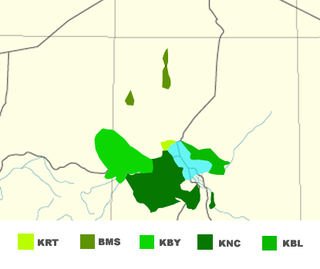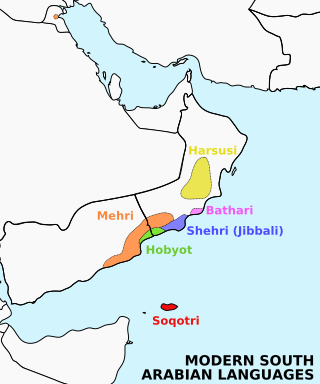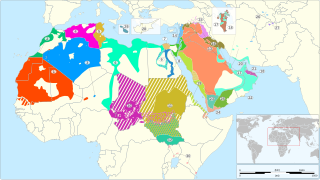
Arabic is a Semitic language spoken primarily across the Arab world. Having emerged in the first millennium BC, it is named after the Arab people; the term "Arab" was initially used to describe those living in the Arabian Peninsula, as perceived by geographers from ancient Greece.

Persian, also known by its endonym Farsi, is a Western Iranian language belonging to the Iranian branch of the Indo-Iranian subdivision of the Indo-European languages. Persian is a pluricentric language predominantly spoken and used officially within Iran, Afghanistan, and Tajikistan in three mutually intelligible standard varieties, namely Iranian Persian, Dari Persian, and Tajiki Persian. It is also spoken natively in the Tajik variety by a significant population within Uzbekistan, as well as within other regions with a Persianate history in the cultural sphere of Greater Iran. It is written officially within Iran and Afghanistan in the Persian alphabet, a derivative of the Arabic script, and within Tajikistan in the Tajik alphabet, a derivative of the Cyrillic script.

Balochi is a Northwestern Iranian language spoken primarily in the Balochistan region of Pakistan, Iran and Afghanistan. In addition, there are speakers in Oman, the Arab states of the Persian Gulf, Turkmenistan, East Africa and in diaspora communities in other parts of the world. The total number of speakers, according to Ethnologue, is 8.8 million. Of these, 6.28 million are in Pakistan.

Kanuri is a Saharan dialect continuum of the Nilo–Saharan language family spoken by the Kanuri and Kanembu peoples in Nigeria, Niger, Chad and Cameroon, as well as by their nomadic and diasporic offshoot communities in southern Libya and western Sudan.

Sorani Kurdish or Central Kurdish, also called Sorani (سۆرانی/Soranî), is a Kurdish dialect or a language that is spoken in Iraq, mainly in Iraqi Kurdistan, as well as the provinces of Kurdistan, Kermanshah, and West Azerbaijan in western Iran. Sorani is one of the two official languages of Iraq, along with Arabic, and is in administrative documents simply referred to as "Kurdish".

Ottoman Turkish was the standardized register of the Turkish language used by the citizens of the Ottoman Empire. It borrowed extensively, in all aspects, from Arabic and Persian, and its speakers used the Ottoman Turkish alphabet for written communication. During the peak of Ottoman power, words of foreign origin in Turkish literature in the Ottoman Empire heavily outnumbered native Turkish words, with Arabic and Persian vocabulary accounting for up to 88% of the Ottoman vocabulary in some texts.

Yemeni Arabic is a cluster of varieties of Arabic spoken in Yemen and southwestern Saudi Arabia. It is generally considered a very conservative dialect cluster, having many classical features not found across most of the Arabic-speaking world.

Kumzari is a Southwestern Iranian language that is similar to the Persian, Achomi and Luri languages. Although vulnerable, it survives today with between 4,000 and 5,000 speakers. It is spoken by Kumzaris on the Kumzar coast of Musandam Peninsula, northern Oman. This is the only Iranian language spoken exclusively in the Arabian Peninsula. Kumzaris can also be found in the towns of Dibba and Khasab as well as various villages, and on Larak Island. The speakers are descendants of fishermen who inhabited the coast of the Persian Gulf and the Gulf of Oman.
The Manus languages are a subgroup of about two dozen Oceanic languages located on Manus Island and nearby offshore islands in Manus Province of Papua New Guinea. The exact number of languages is difficult to determine because they form a dialect continuum. The name Manus originally designated an ethnic group whose members spoke closely related languages and whose coastal dwellers tended to build their houses on stilts out over the sea.
A macrolanguage is a book-keeping mechanism for the ISO 639 international standard of language codes. Macrolanguages are established to assist mapping between different sets of ISO language codes. Specifically, there may be a many-to-one correspondence between ISO 639-3, intended to identify all the thousands of languages of the world, and either of two other sets, ISO 639-1, established to identify languages in computer systems, and ISO 639-2, which encodes a few hundred languages for library cataloguing and bibliographic purposes. When such many-to-one ISO 639-2 codes are included in an ISO 639-3 context, they are called "macrolanguages" to distinguish them from the corresponding individual languages of ISO 639-3. According to the ISO,
Some existing code elements in ISO 639-2, and the corresponding code elements in ISO 639-1, are designated in those parts of ISO 639 as individual language code elements, yet are in a one-to-many relationship with individual language code elements in [ISO 639-3]. For purposes of [ISO 639-3], they are considered to be macrolanguage code elements.
The Arabic language family is divided into several categories which are: Old Arabic, the literary varieties, and the modern vernaculars.
North Levantine Arabic was defined in the ISO 639-3 international standard for language codes as a distinct Arabic variety, under the apc code. It is also known as Syro-Lebanese Arabic, though that term is also used to mean all of Levantine Arabic.

Shehri, also known as Jibbali, is a Modern South Arabian language; it and the three island varieties of Soqoṭri comprise the eastern branch of Modern South Arabian. It is spoken by a small native population inhabiting the coastal towns and the mountains and wilderness areas upland from Salalah, located in the Dhofar Governorate in southwestern Oman. The autonym for speakers is əḥklí, plural əḥkló.

Varieties of Arabic are the linguistic systems that Arabic speakers speak natively. Arabic is a Semitic language within the Afroasiatic family that originated in the Arabian Peninsula. There are considerable variations from region to region, with degrees of mutual intelligibility that are often related to geographical distance and some that are mutually unintelligible. Many aspects of the variability attested to in these modern variants can be found in the ancient Arabic dialects in the peninsula. Likewise, many of the features that characterize the various modern variants can be attributed to the original settler dialects as well as local native languages and dialects. Some organizations, such as SIL International, consider these approximately 30 different varieties to be separate languages, while others, such as the Library of Congress, consider them all to be dialects of Arabic.
Karas is a divergent Trans–New Guinea language spoken on the biggest of the Karas Islands off the Bomberai Peninsula, that appears to be most closely related to the West Bomberai languages. It is spoken in Antalisa and Mas villages on Karas Island.

Kagate or Syuba is a language from the subgroup of Tibetic languages spoken by the Kagate people primarily in the Ramechhap district of Nepal.

Kalanguya, also called Kallahan, is a dialect cluster spoken by the Kalanguya people of northern Luzon, Philippines.
Luang, also known as Literi Lagona, is an Austronesian language spoken in the Leti Islands and the Babar Islands in Maluku, Indonesia. It is closely related to the neighboring Leti language, with 89% shared basic vocabulary.
Beary or Byari is a Dravidian language spoken by the Bearys who are part of the Muslim community in Tulu Nadu region of Southern Karnataka and Northern Kerala. The community is often recognized as Bearys or Beary Muslims. Beary language is made of Tulu phonology and grammar with Malayalam idioms. Due to the trading role of the community, the language acquired loan words from other languages of Tulu, Malayalam, Kannada and also from Perso-Arabic sources.
Daatsʼiin is a B'aga language of western Ethiopia. There are two communities of speakers in western Ethiopia, one in Mahadid, on the northeast border of Alitash National Park, and one in Inashemsh on the Sudan border, south of the park where the Rahad River crosses from Ethiopia into Sudan.












